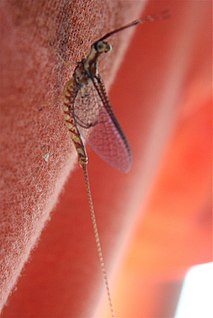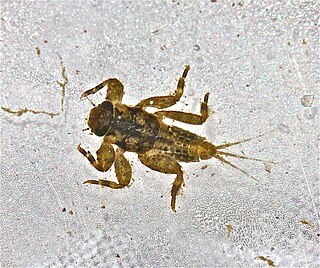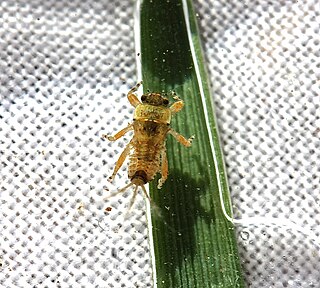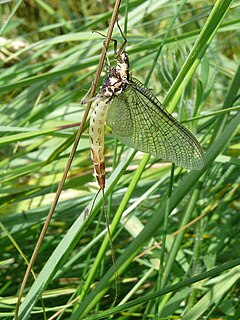
Mayflies are aquatic insects belonging to the order Ephemeroptera. This order is part of an ancient group of insects termed the Palaeoptera, which also contains dragonflies and damselflies. Over 3,000 species of mayfly are known worldwide, grouped into over 400 genera in 42 families.

The Pentatomoidea are a superfamily of insects in the Heteroptera suborder of the Hemiptera order. As Hemiptera, they share a common arrangement of sucking mouthparts. The roughly 7000 species under Pentatomoidea are divided into 21 families. Among these are the shield bugs, giant shield bugs, burrower bugs, and stink bugs.

The Haliplidae are a family of water beetles who swim using an alternating motion of the legs. They are therefore clumsy in water, and prefer to get around by crawling. The family consists of about 200 species in 5 genera, distributed wherever there is freshwater habitat; it is the only extant member of superfamily Haliploidea. They are also known as crawling water beetles or haliplids.
The most recent understanding of the evolution of insects is based on studies of the following branches of science: molecular biology, insect morphology, paleontology, insect taxonomy, evolution, embryology, bioinformatics and scientific computing. It is estimated that the class of insects originated on Earth about 480 million years ago, in the Ordovician, at about the same time terrestrial plants appeared. Insects may have evolved from a group of crustaceans. The first insects were landbound, but about 400 million years ago in the Devonian period one lineage of insects evolved flight, the first animals to do so. The oldest insect fossil has been proposed to be Rhyniognatha hirsti, estimated to be 400 million years old, but the insect identity of the fossil has been contested. Global climate conditions changed several times during the history of Earth, and along with it the diversity of insects. The Pterygotes underwent a major radiation in the Carboniferous while the Endopterygota underwent another major radiation in the Permian.
The arthropod leg is a form of jointed appendage of arthropods, usually used for walking. Many of the terms used for arthropod leg segments are of Latin origin, and may be confused with terms for bones: coxa, trochanter, femur, tibia, tarsus, ischium, metatarsus, carpus, dactylus, patella.

Ephemerellidae are known as the spiny crawler mayflies. They are a family of the order Ephemeroptera. There are 8 genera consisting of a total 90 species. They are distributed throughout North America as well as the UK. Their habitat is lotic-erosional, they are found in all sizes of flowing streams on different types of substrates where there is reduced flow. They are even found on the shores of lakes and beaches where there is wave action present. They move by swimming and clinging, they are very well camouflaged. Most species have one generation per year. They are mostly collector-gatherers.

Leptophlebiidae is a family belonging to the Ephemeropterans that are commonly known as the prong-gilled mayflies or leptophlebiids. It is the only family in the superfamily Leptophlebioidea. In North America they occur with about 70 species from 9 genera in freshwater streams and lakes; in Europe they are somewhat less diverse. Globally, this family is much more prevalent and diverse, with about 2000 different species. Leptophlebiids are easily recognized by the forked gills present on the larvae's abdomen, thus their common name.
Cinygmula is a genus of flatheaded mayflies in the family Heptageniidae. There are at least 30 described species in Cinygmula.

Coxoplectoptera or "chimera wings" is an extinct order of winged insects containing one family, Mickoleitiidae. Coxoplectopterans are closely related to the mayflies.

Branchiobdellida is an order of freshwater leech-like clitellates that are obligate ectosymbionts or ectoparasites, mostly of astacoidean crayfish. They are found in the Northern Hemisphere and have a holarctic distribution in East Asia, the Euro-Mediterranean region and North and Central America, with the greatest species diversity being in North and Central America.
Dolania is a monotypic genus of mayfly in the family Behningiidae containing the single species Dolania americana. It is found in the southeastern United States, as far south as Florida, and is generally uncommon. The adult insects emerge before dawn in early summer, mate and die within the space of about thirty minutes. The female deposits her eggs in the water and dies within five minutes of emergence, believed to be the shortest adult lifespan of any insect.

Hexagenia limbata, the giant mayfly, is a species of mayfly in the family Ephemeridae. It is native to North America where it is distributed widely near lakes and slow-moving rivers. The larvae, known as nymphs, are aquatic and burrow in mud and the adult insects have brief lives. They are often referred to as fish flies around the Great Lakes as they tend to cause the areas around water to smell like rotten fish.

Hexagenia bilineata is a species of mayfly in the family Ephemeridae. It is native to North America where it is found in the Upper Mississippi Valley. Sometimes adults of this mayfly are so abundant as to cause a nuisance because of their enormous numbers. The larvae are aquatic and burrow in mud and the adult insects have brief lives.

Drunella is a genus of spiny crawler mayflies in the family Ephemerellidae. There are at least 20 described species in Drunella.
Behningia is a genus of sand-burrowing mayfly in the family Behningiidae. There are at least four described species in Behningia.
Protobehningia is a genus of sand-burrowing mayfly in the family Behningiidae. There are at least two described species in Protobehningia.

Ephemera simulans is a species of mayfly. It is commonly found throughout the United States. The species is used for fly fishing.

Ephemerella is a genus of spiny crawler mayflies in the family Ephemerellidae. There are about 19 described species in Ephemerella.

Polymitarcyidae is a family of pale burrower mayflies in the order Ephemeroptera. There are about 10 genera and more than 90 described species in Polymitarcyidae.
Acanthametropodidae is a family of sand-dwelling mayflies in the order Ephemeroptera. There are at least two genera and four described species in Acanthametropodidae.












